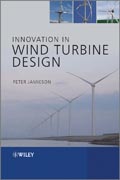
Innovation in Wind Turbine Design addresses the fundamentals of design, the reasons behind design choices, and describes the methodology for evaluating innovative systems and components. Always referencing a state of the art system for comparison, Jamieson discusses the basics of wind turbine theory and design, as well as how to apply existing engineering knowledge to further advance the technology, enabling the reader to gain a thorough understanding of current technology before assessing where it can go in the future. Innovation in Wind Turbine Design is divided into four main sections covering design background, technology evaluation, design themes and innovative technology examples: Section 1 reviews aerodynamic theory and the optimization of rotor design, discusses wind energy conversion systems, drive trains, scaling issues, offshore wind turbines, and concludes with an overview of technology trends with a glimpse of possible future technology Section 2 comprises a global view of the multitude of design options for wind turbine systems and develops evaluation methodology, including cost of energy assessment with some specific examples Section 3 discusses recurrent design themes such as blade number, pitch or stall, horizontal or vertical axis Section 4 considers examples of innovative technology with case studies from real-life commercial clients. This groundbreaking synopsis of the state of the art in wind turbine design is must-have reading for professional wind engineers, power engineers and turbine designers, as well as consultants, researchers and academics working in renewable energy. ÍNDICE: ACKNOWLEDGMENTS PREFACE INTRODUCTION0.1 Why Innovation?0.2 The Challenge of Wind0.3 The Specification of a Modern Wind Turbine0.4 The Variability of the Wind0.5 Commercial Wind Technology0.6 Basis of Wind Technology Evaluation0.7 REFERENCES for Chapter 0 PART ONE - DESIGN BACKGROUND 1 ROTOR AERODYNAMIC THEORY1.1 Introduction1.2 Aerodynamic Lift1.3 The Actuator Disc1.4 Open Flow Actuator Disc1.5 Generalised Actuator Disc Theory1.6 The Force on a Diffuser1.7 Generalised Actuator Disc Theory and Realistic Diffuser Design1.8 Why a Rotor?1.9 Basic Operation of a Rotor1.10 Blade Element Momentum Theory1.11 Optimum Rotor Theory1.12 Limitations of Actuator Disc and BEM Theory1.13 REFERENCES for Chapter 1 2 ROTOR AERODYNAMIC DESIGN2.1 Optimum Rotors and Solidity2.2 Rotor Solidity and Ideal Variable Speed Operation2.3 Solidity and loads2.4 Aerofoil Design Development2.5 Sensitivity of Aerodynamic Performance to Planform Shape2.6 Aerofoil Design Specification2.7 REFERENCES for Chapter 2 3 ROTOR STRUCTURAL INTERACTIONS3.1 Introduction3.2 Blade Design in General3.3 Basics of Blade Structure3.4 Simplified Cap-Spar Analyses3.5 The Effective t/c Ratio of Aerofoil Sections3.6 Blade design studies - example of a parametric analysis3.7Industrial Blade Technology3.8 REFERENCES CHAPTER 3 4 UP SCALING OF WIND TURBINE SYSTEMS4.1 Introduction - size and size limits4.2 The 'Square-Cube' Law4.3Scaling Fundamentals4.4 Similarity Rules for Wind Turbine Systems4.5 Analysisof Commercial Data4.6 Upscaling of VAWTs4.7 Rated tip speed4.8 Upscaling of Loads4.9 Violating Similarity4.10 Cost Models4.11 Scaling Conclusions4.12 REFERENCES CHAPTER 4 5 WIND ENERGY CONVERSION CONCEPTS5.1 REFERENCES FOR CHAPTER 5 6 DRIVE TRAIN DESIGN6.1 Introduction6.2 Definitions6.3 Objectives of Drive Train Innovation6.4 Drive Train Technology Maps6.5 Direct Drive6.6 Hybrid Systems6.7 Hydraulic transmission6.8 Efficiency of Drive Train Components6.9 The Optimum Drive Train6.10 Innovative concepts for power take-off6.11 REFERENCES FOR CHAPTER 6 7 OFFSHORE WIND TURBINES7.1 Design for Offshore7.2 High Speed Rotor7.3 'Simpler' Offshore Turbines7.4 Offshore Floating Turbine Systems7.5 REFERENCES FOR CHAPTER 7 8 TECHNOLOGY TRENDS SUMMARY8.1 Evolution8.2 Consensus in blade number and operational concept8.3 Divergence in drive train concepts8.4 Future wind technology8.5 REFERENCES FOR CHAPTER 8 PART TWO - TECHNOLOGY EVALUATION 9 COST OF ENERGY9.1 The Approach to Cost of Energy9.2 Energy - The Power Curve9.3 Energy- Efficiency, Reliability, Availability9.4 Capital Costs9.5 Operation and Maintenance9.6 Overall Cost Split9.7 Scaling Impact on Cost9.8 Impactof Loads (Site Class)9.9 REFERENCES FOR CHAPTER 9 10 EVALUATION METHODOLOGY10.1 Key Evaluation Issues10.2 Fatal Flaw Analysis10.3 Power Performance10.4 Drive train torque10.5 Representative Baseline10.6 Design Loads Comparison10.7 Evaluation Example - Optimum Rated Power of a Wind turbine10.8 Evaluation Example - The Carter Wind
- ISBN: 978-0-470-69981-2
- Editorial: John Wiley & Sons
- Encuadernacion: Cartoné
- Páginas: 328
- Fecha Publicación: 09/09/2011
- Nº Volúmenes: 1
- Idioma: Inglés
